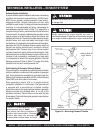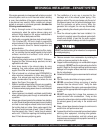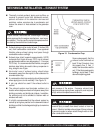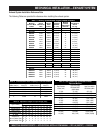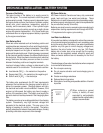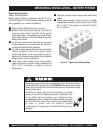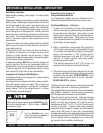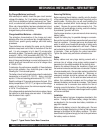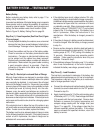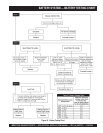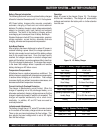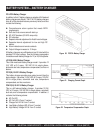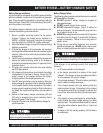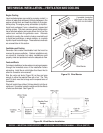
PAGE 54 — INDUSTRIAL GENERATOR SETS — APPLICATION & INSTALLATION MANUAL — REV. #4 (09/07/07)
BATTERY SYSTEM — TESTING BATTERY
Battery Testing
Before conducting any battery tests, refer to page 11 for
battery safety instructions
.
Low water-loss batteries of the latest design may incorporate
flame-arrester vents to reduce the possibility of explosions
caused by external sparks. Therefore, during charging and
testing, the flame-arrester vents should remain in place.
Refer to Figure 18,
Battery Testing Chart
on page 55.
Step One (1) - Visual Inspection (See Flow Chart, Figure
18 on next page)
a. Visually inspect the battery for container, cover, or terminal
damage that may have caused leakage of electrolyte or
internal damage. If damage is found, replace the battery.
b. Check the condition and the size of the battery cables.
Check for corrosion on the battery terminals and cable
terminations. Corrosion on side terminal batteries may
not be evident until the cables have been removed.
Replace badly corroded cables or cables with defective
terminations. Make certain the ground cable is making
a good connection where it is grounded. Check the
connection of the cable to the starter relay or solenoid.
Proceed to step two.
Step Two (2) - Electrolyte Levels and State of Charge
Although these batteries are designed to preclude adding
water, the volume of reserve electrolyte above the plates
may eventually be depleted. In most cases, this will signal
the end of the battery's useful life. Since many have sealed
covers in place of filler caps, it may not be possible to check
the electrolyte levels by looking directly into the cells.
However, many low water loss batteries are contained in
translucent plastic cases which may allow electrolyte levels
to be seen. Other models utilize built-in hydrometers which
also serve as electrolyte level indicators. If electrolyte levels
can be seen and found to be low, check for a charging system
malfunction.
If the electrolyte level is below the top of the plates in any
cell, and if vents are removable, add water before proceeding
further. If water cannot be added, replace the battery.
The battery must be at an adequate state of charge in order
for the following load test to be valid. If the battery does not
contain a built-in hydrometer, the state-of charge can be
estimated with an accurate voltmeter.
a. If the stabilized open circuit voltage is below 12.4 volts,
charge the battery (or check battery charger connection).
A stabilized voltage reading is assumed after the battery
has remained on open circuit for a minimum of 4 hours
or, preferably, overnight. When a hydrometer reading can
be taken, a value of 1.225 @ 80°F (26.7°C) can be used
instead of the 12.4 voltage reading. If the battery has a
built-in hydrometer, follow the instructions of the
manufacturer. After the battery is charged, proceed to
step 2.c.
b. If the state-of-charge of a battery cannot be determined,
it must be charged. After the battery is charge, proceed
to step 2.c.
c. Remove surface charge by attaching load test leads to
the terminals and applying a load equal to 1/2 of the cold
cranking amps at 0°F (-17.8°C) rating of the battery for
15 seconds. Manufacturers may prescribe specific
methods. Follow specific instructions when they are
available. Proceed to step 3.
d. If the stabilized voltage of the battery was 12.4 or above
when it was first examined, or the built-in hydrometer
indicated the battery was charge, proceed to step 3.
Step Three (3) - Load Procedure
The load test is conducted to determine if the battery has
adequate electrical performance or if it has to be replaced.
This procedure is valid only if the battery is at or above the
state of charge specified in step 2.
a. Connect the voltmeter and load test leads to the battery
terminals; be sure the load switch is in the "Off" position
Proceed to step 3.b.
b. Apply a load test equal to 1/2 of the cold cranking rating
of the battery at 0°F (-17.8°C). Read voltage after fifteen
(15) seconds with the load connected. Remove load.
Estimate or measure the battery temperature and
compare voltage reading with the voltage chart (see
Figure 17 on page 53). If the voltage is less than the
minimum specified, replace the battery. If the voltage
meets or exceeds the specified minimum, return the
battery to service.



